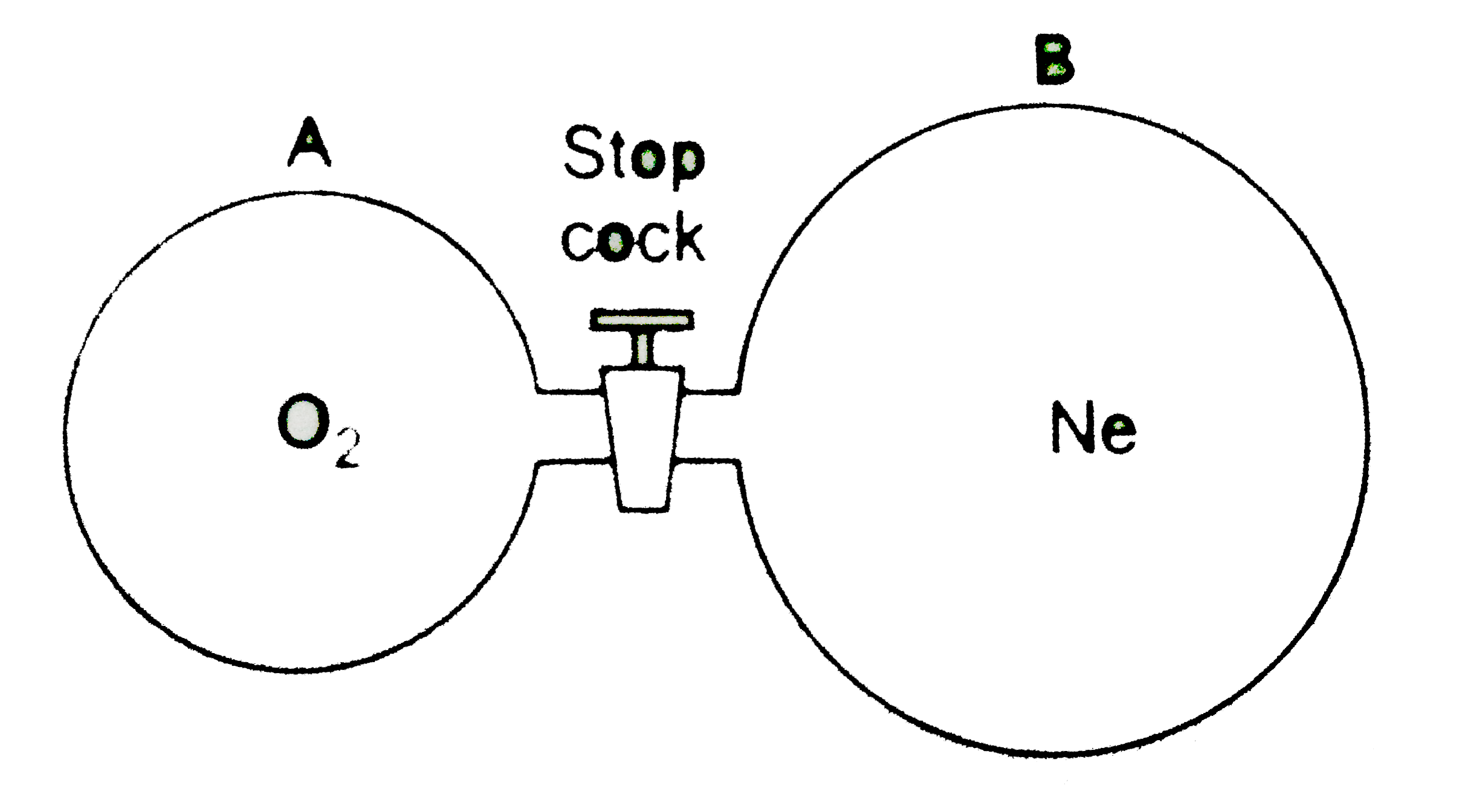Consider the adjacent diagram. Initially, flask A contained oxygen gas at 27∘C and 950mm of Hg, and flask B contained neon gas at 27∘C and 900mm. Finally, two flask were joined by means of a narrow tube of negligible volume equipped with a stopcock and gases were allowed to mixup freely. The final pressure in the combined system was found to be 910mm of Hg.

If flask B were heated to 127∘C, maintaining flask A at constant temperature of 27∘C, final pressure (in mmHg) in the combined system would have been
1007
1250
1137.5
1990
n→tal=Const.

⇒950×VAR×300+900×VBR×300=P×VAR×300+P×VBR×400
⇒950VA+900×4VA=P×VA+34×P×(4VA)
⇒P=950+900×41+3=1137.5mmHg
Topper's Solved these Questions
- STATES OF MATTERBOOK - CENGAGE CHEMISTRY ENGLISHCHAPTER - STATES OF MATTEREXERCISE - Exercises (Multiple Correcttype)
32 Videos
- STATES OF MATTERBOOK - CENGAGE CHEMISTRY ENGLISHCHAPTER - STATES OF MATTEREXERCISE - Exercises (Single Correct)
85 Videos
- STATES OF MATTERBOOK - CENGAGE CHEMISTRY ENGLISHCHAPTER - STATES OF MATTEREXERCISE - Linked Comprehensive
2 Videos
- SOME BASIC CONCEPTS AND MOLE CONCEPTBOOK - CENGAGE CHEMISTRY ENGLISHCHAPTER - SOME BASIC CONCEPTS AND MOLE CONCEPTEXERCISE - Archives Subjective
11 Videos
- STOICHIOMETRYBOOK - CENGAGE CHEMISTRY ENGLISHCHAPTER - STOICHIOMETRYEXERCISE - Archives Subjective
33 Videos
Similar Questions
Consider the adjacent diagram. Initially, flask A contained oxygen gas at 27∘C and 950mm of Hg, and flask B contained neon gas at 27∘C and 900mm. Finally, two flask were joined by means of a narrow tube of negligible volume equipped with a stopcock and gases were allowed to mixup freely. The final pressure in the combined system was found to be 910mm of Hg.

What is the correct relationship between volumes of the two flasks?
View SolutionConsider the adjacent diagram. Initially, flask A contained oxygen gas at 27∘C and 950mm of Hg, and flask B contained neon gas at 27∘C and 900mm. Finally, two flask were joined by means of a narrow tube of negligible volume equipped with a stopcock and gases were allowed to mixup freely. The final pressure in the combined system was found to be 910mm of Hg.

Which of the following statements concerning oxygen and neon gas is true in the begining, when the stopcock was just opened?
View SolutionInitially bulb "a" contained oxygen gas at 27∘C and 950 mm of Hg and bulb "B" contained neon gas at 27∘C and 900 mm of Hg. These bulbs are connected by a narrow tube of negligible volume equipped with a stopcock and gases were allowed to mix-up freely. The pressure obtained in the combined system was found to be 910 mm of Hg.

If volume of bulb B was measured to be 10 L, then find the volume of oxygen gas present initially in bulb "A" .
View SolutionCalculate the volume occupied by 7 g of nitrogen gas at 27∘C and 750 mm Hg pressure
View Solution2L of SO2 gas at 760 mm Hg are transferred to 10 L flask containing oxygen at a particular temperature, the partial pressure of SO2 in the flask is
View SolutionTwo flasks of equal volumes have been joined by a narrow tube of negligible volume. Initially both the flasks are 300 K and totally 9 mole of gas is present. One of the flasks is then placed in a thermostat at 600K. How many moles of gas is present in hot bulb.
View SolutionCalculate RMS velocity of ethane at 27∘ C and 720 mm of Hg pressure.
View SolutionAt constant temperature, a gas is at a pressure of 1080 mm Hg. If the volume is decreased by 40%, find the new pressure of the gas.
View SolutionA gas occupies a volume of 300 cm3 at 27.∘C and 620 mm pressure . The volume of gas at 47.∘C and 640 mm pressure is
View SolutionA gas occupies a volume of 300 cm3 at 27.∘C and 620 mm pressure . The volume of gas at 47.∘C and 640 mm pressure is
View Solution
